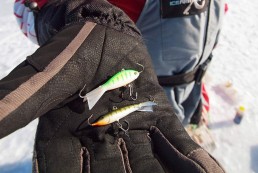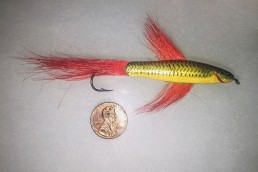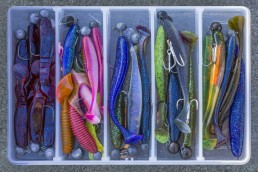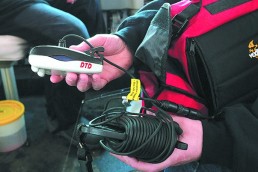Hitting ‘Rock Bottom’
SHARE THIS POST
Not much else grabs your attention more than noise. And the same holds true for fish. In fact, no matter the species, fish will rely on the very sounds forage make to help them zone in on their next meal. In ice fishing, you’re very limited in the areas you’re able to fish within a waterway, directly below the holes you drill. To get the attention of any fish that may be nearby but not directly under you, your lure has to make a lot of racket to get noticed.
There are lures of all sorts on the pegs of the walls of your favorite bait-and-tackle shop. Some are finished with noise-making devices built within while some are boisterous in shape alone, or there are ones that share a little of both. All declare they will attract fish from afar. But sometimes it takes more than just the ordinary wiggle and jiggle of a lure to get fish to bite. Often, it’s how aggressively you fish, and where in the water column your lure is that will trip the triggers to make fish feed. But sometimes you have to hit “rock bottom” to make it into the big-fish-catching league.
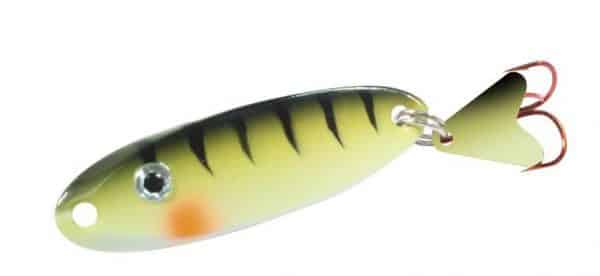
On the softer side
Early on in the day and before I get loud with lures I’m careful to be the opposite of noisy—I try to be as stealthy as can be. Before the crack of dawn I crank up my ultra-quiet StrikeMaster Honda 35CC Lite and drill as many holes as I can. This way I’m sure to have at least punched one hole over structure before the bite starts. Couple this engine with the ultra-sharpness and shape of StrikeMaster’s blades and I’m able to drill holes 10 inches in diameter quickly, efficiently and quietly, allowing time for the environment to settle down under me well before the sun rises up over the horizon.
To increase the efficiency of walking on ice, as well my own safety, I’ll use ice cleats on the soles of my Ice Armor Onyx boots, all the while keeping my footsteps quiet. The traction on the soles of these is excellent and the added grip of the spikes aids in my proficiency on smooth, slick, icy surfaces. Cleats with short spikes are much quieter than the large fang-like spears found on some ice walking aids.
Now, rather than later
As quickly as possible, I’ll walk hole to hole and check for depth and see if there are any fish below me with my Lowrance HOOK-5 Ice Machine, which is a portable sonar and GPS. What I’m looking for besides fish (obviously) is hard-bottomed areas of any kind—especially those with rocks adjacent to a drop-off or a hump. These areas are easy to find, as the hard bottom shows up as a thin, brightly colored line on the color readout. I can then figure out which way the bottom falls off by paying attention to the depth of each hole. An SD card filled with Navionics mapping in the unit’s card reader helps this process.
Once a hard bottom is found on sonar, I can confirm what it’s made up of via my MarCum Recon 5 Plus Underwater Viewing system. I can see firsthand the composition of the lake’s bottom, especially rocks, through any dingy water. I’m looking for rocky bottoms so I can bang my lure off these hard surfaces every so often. The banging of a lure on rocks can be very loud to them.
Are you enjoying this post?
You can be among the first to get the latest info on where to go, what to use and how to use it!
I’m also using line with very little or no stretch like 12-pound-test Berkley FireLine, which I’ll use as my main line, and then go to a 1-foot leader of Berkley’s Fluorocarbon line at 10-pound-test. I connect the two via a small Berkley Ball Bearing Swivel. When ice fishing, I always connect my lure to the fluorocarbon by a Berkley Cross-Lok Snap, rather than a snap swivel, as the latter adds too much hardware and bulk to the rig.
Banging on the bottom works well with all my favorite lures, whether they are metal jigging spoons or hard-bodied baits. Personally, I like Northland’s UV Macho Minnows that are painted in six different ultra-violet hues, including glow-in-the-dark. It’s a heavy lure and raps well against a hard bottom. And speaking of rapping, Rapala’s Jigging Shad Raps and Jigging Raps work wonders for creating chaos on hard bottoms too.
So when is the right time for whacking rocks with your bait?
I like to thump the bottom every few minutes until a fish is either spotted on my sonar or depth finder, and then I’ll fish it as I normally would off the bottom. Tapping the hard-bottom areas work well when a hole has gone dry and the fish have left the area, or when I get a strike but the fish have missed a lure. In the case of a missed strike, I’ll drop the lure to the bottom immediately and rap it on the bottom quite a few times. Then I’ll lift it up and let it set for a few seconds. Most of the time fish will either hit it as the lure flounders on bottom or as it sits there motionless.
Rock rapper
Drawing attention to your lure is often as easy as hitting the rocky bottom with it. But remember to be stealthy in your approach and then let your lure be the loud device. Drill lots of holes quickly but not with too much noise, check for depth and the bottom composition, then fish. If the fish leave or you get a strike but miss, drop your lure to the bottom and let it knock the floor. The strike that occurs next might just rock your world.
MWO
SHARE THIS POST
Did you enjoy this post?
You can be among the first to get the latest info on where to go, what to use and how to use it!
Mark Martin
Mark Martin is a professional walleye tournament angler and instructor with the Ice Fishing School/Vacation series. For more information, check out his website at markmartins.net or fishingvacationschool.com.

